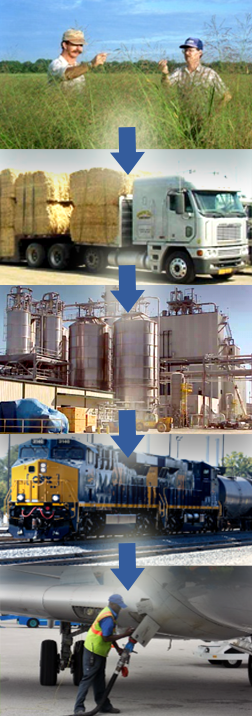From Farm to Flight: Evaluating Canola-Based Jet Fuels
Aviation accounts for about 8 percent of greenhouse gas (GHG) emissions from the transportation sector. To reduce commercial aviation emissions that contribute to climate change, the solution may seem simple: develop alternative fuels that emit fewer GHGs than fossil fuels.
Indeed, the Federal Aviation Administration (FAA) is working toward enabling one billion gallons per year of sustainable alternative jet fuels in the U.S. by 2018. But, the solution isn’t quite so straightforward.
That’s because it takes energy to make energy.
Many alternative jet fuels are biofuels—they come from agricultural crops, such as canola, that extract carbon out of the air to grow. That carbon is then re-released when biofuels are burned, creating a cycle. But there are also emissions associated with growing the crop, processing it, and refining it into usable jet fuel.
Through the entire process, from farm to flight, there are also transportation emissions. For example, a farmer might use a diesel tractor to bring canola seed to a freight truck, which might carry the seed to a train. That train could drop off the seed at a refinery, with pipeline delivering the processed fuel to an airport. Transportation emissions are part of the equation for researchers considering the environmental impacts of producing alternative fuels.
Transportation Emissions and Alternative Fuel Production
The Volpe-developed Freight and fuel Transportation Optimization Tool (FTOT) lets researchers hone in on multimodal transportation emissions associated with producing alternative fuels.
Volpe created FTOT in part to complement ongoing U.S. Department of Agriculture-funded research on oilseed production potential in the wheat-belt to make biojet fuel. As part of that assessment, researchers from Michigan Technological University performed a full chain life-cycle assessment of GHGs for canola-based jet fuels. But FTOT is a flexible platform for many types of scenarios for fuels and other commodities.
“FTOT is meant to be used for all kinds of data on raw and processed materials across the transportation network,” said Dr. Kristin Lewis, a Volpe environmental biologist who led the development of FTOT. “It really can be used for a variety of future energy transportation scenarios, and that’s key.”
The researchers assessing canola-based jet fuels modeled how changes in canola prices would affect emissions related to producing canola fuel. They assumed that if the price of canola increased, more farmers would grow it.
Building a Transportation Network with FTOT
For the portion of their analysis focused on transportation emissions, the researchers collaborated with Volpe to use FTOT to build a model transportation network for canola fuel production, specifically to do the following:
- Generate biorefinery candidate locations where canola oil could reasonably be aggregated, extracted, and converted to fuel.
- Optimize routing for moving seed from growing locations to refineries to airports, based on the lowest transportation and loading costs, biorefinery capital costs, preferences for larger roadways, and minimum and maximum capacities of conversion facilities.
With these parameters, FTOT supplied researchers with routes, flows, costs, number of vehicle loads, vehicle miles traveled, carbon dioxide emissions, and fuel consumption for transporting feedstock and fuel.
FTOT Available for Researchers
Volpe developed FTOT for FAA, the Department of Energy, and the Office of Naval Research, but any alternative fuel researcher can contact Volpe to explore its capabilities and possible collaborations.
“The canola-based fuel research demonstrates that FTOT has real utility for researchers in this field,” Lewis said. “In addition to other alternative fuel studies, we also plan on using it to look at crude oil, petroleum products, and coal, and we’re open to other uses as we continue to make it more flexible. FTOT doesn’t have a user interface—it’s an in-house process—but we’re very happy to work with agencies and organizations that are interested in it.”

